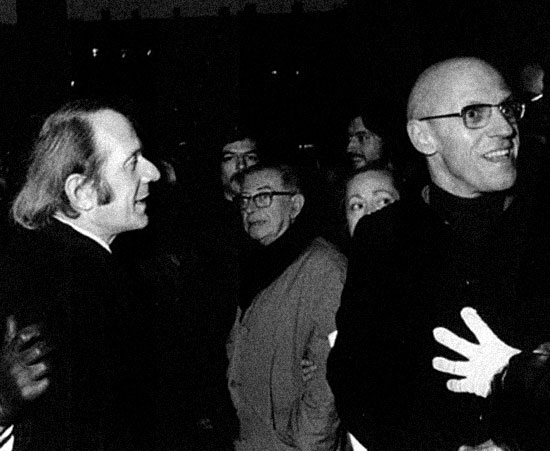Jodi Dean, “Politics without Politics,” Parallax 15.3 (2009): 20–36.
See Comité Invisible, A nos amis (Paris: La fabrique, 2014), 72–83.
These were some of the questions posed at the Sharjah March Meeting in May 2015.
See Angela Y. Davis, Mujeres, raza y clase (Madrid: AKAL, 2004), 157–159.
Gilles Deleuze and Michel Foucault, “Intellectuals and Power: A Conversation Between Michel Foucault and Gilles Deleuze,” Language, Counter-memory, Practice, ed. Donald F. Bouchard (Ithaca: Cornell University Press, 1977).
See Maurizio Lazzarato, “From Knowledge to Belief, from Critique to the Production of Subjectivity,” Transversal, April 2008 →
See Irmgard Emmelhainz, “From From Third Worldism to Empire: Jean‐Luc Godard and the Palestine Question,” Third Text 23.100 (Fall 2009): 649–656.
See Stuart Hall, “Old and New Identities, Old and New Ethnicities,” Culture, Globalization and the World-System: Contemporary Conditions for the Representations of Identity, ed. Anthony D. King (Minneapolis: University of Minnesota Press, 1997), 43.
Homi Bhabha, “Frontlines/Borderposts,” in Displacements: Cultural Identities in Question, ed. Angelika Bammer (Bloomington: Indiana University Press, 1994), 269.
Susan Buck-Morss, Thinking Past Terror: Islamism and Critical Theory on the Left (London: Verso, 2003), 64.
See Boris Groys, “The Post-Communist Condition” →
Brian Holmes, “Continental Drift: Activist Research, From Geopolitics to Geopoetics,” framework X ephemera 5.X (2005): 741.
See Gregory Sholette, “Art Out of Joint: Artists’ Activism Before and After the Cultural Turn,” The GULF: High Culture/Hard Labor, ed. Andrew Ross (New York: OR Books, 2015), 80.
Holmes, “Continental Drift,” 741.
See Peter Osborne, “The Postconceptual Condition or, the Cultural Logic of High Capitalism Today,” Radical Philosophy 184 (March-April 2014): 19. This singular modernity is akin to what Nicolas Bourriaud termed the “Altermodern” in his Altermodern (London: Tate Publishing, 2009).
See Claire Bishop, “Antagonism and Relational Aesthetics,” October 110 (Fall 2004): 51–79.
As in Santiago Sierra’s confrontations or in Thomas Hirschhorn’s Bataille Monument (2002), which was part of Documenta 11. Ibid.
See Grant Kester, Conversation Pieces: Community and Communication in Modern Art (Los Angeles: University of California Press, 2004).
Eyal Weizman, “The Paradox of Participation,” introduction to Markus Miessen, The Nightmare of Participation (Frankfurt: Sternberg Press, 2011), 9.
Wendy Brown, Undoing the Demos: Neoliberalism’s Stealth Revolution (New York: Zone Books, 2015),
Ibid., 129.
Mitchell delivered these remarks in a lecture at the 2015 Sharjah March Meeting. The voice-over in Godard’s Histoire(s) du cinema (1998) says the following: “Même s’il est bondé d’égratignures au point de ne plus être utilisable, un petit rectangle de 35 millimètres est capable de sauver l’honneur de la réalité toute entière” [Even fatally scratched, a small rectangle of 35 millimeters is capable of saving the honor of the whole of reality
See Global Ultra Luxury Faction (G.U.L.F.), “On Direct Action: An Address to Cultural Workers,”in The GULF, 134.
“Global Ultra Luxury Faction (G.U.L.F.) Manifesto,” June 25, 2015 →
See “Artists at Istanbul Biennial plan ‘Productive disruption’ to demand resumption of peace talks,” e-flux conversations, September 1, 2015 →
See Hrag Vartanian, “Artists Launch Letter for Palestine Campaign at Venice Biennale,” Hyperallergic, August 13, 2015 →
See Guy Mannes-Abbott, “The Emergent Wave of Artworld Activism,” The GULF, 98.
Sholette, “Art Out of Joint,” 83.
Comité Invisible, A nos amis, 84–86.
The author would like to thank @Stephanie Bailey @Saúl Hernández @Urok Shirhan @Fawwaz Trablousi @Rolando Vazquez and eveyone at #sharjahmarchmeeting2015.
